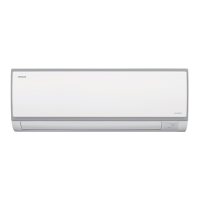Do you have a question about the Hitachi RPK-2.0FSNM and is the answer not in the manual?
Immediate hazards resulting in severe injury or death. Handle with extreme caution.
Notes on potential hazards or unsafe practices requiring careful handling.
Recommendations for ventilation and system operation.
Highlights dangers associated with the high-pressure vessel and safety devices.
Procedures for starting the system and periodic maintenance checks.
Details on maximum allowable pressure and cut-out values.
Information regarding labels for the pressure vessel under PED.
Warning against modifying the high-pressure switch to prevent explosion risk.
Electrical power supply requirements and precautions before starting the system.
Detailed operation of the PC-P1HE remote control unit.
Explanation of indicators and buttons on the remote control unit.
Important notes regarding system usage with the remote control.
Step-by-step guide for operating the system in different modes.
Instructions for adjusting temperature, fan speed, and air flow direction.
How to adjust the swing louver for optimal air distribution.
Steps to set and cancel the timer operation for the system.
How to operate the ventilation function, requiring a heat exchanger.
Setting automatic mode for cooling/heating based on temperature.
Detailed procedures and diagrams for adjusting swing louvers on different unit types.
Warning against manually forcing the air louver, which can cause damage.
Indicates fan speed changes in heating operation.
Shows when defrost operation is active and its effect on louvers.
Indicates when the filter needs cleaning and how to reset.
Indicates RUN lamp blinking and ALARM display for unit issues.
Shows all indications are OFF during power failure.
Indicates unit stop due to microcomputer protection from electric noise.
Instructions for removing connectors when using wireless remote.
Ensures compressor remains off for 3 minutes after stopping.
Prevents frost by changing to fan operation during low-temp cooling.
System restarts automatically after short power interruptions.
Fan speed is set to slow during heating operation under certain conditions.
Performs defrosting to prevent frosting on the outdoor unit.
Stops heating operation to prevent overload due to high outdoor temp.
Controls fan speed to prevent cold air discharge during heating.
Cautions regarding water leakage, smoke, or abnormal smells.
Explains normal sounds from thermal deformation and refrigerant flow.
Checks if the set temperature is correct for no operation.
Checks for airflow obstruction, room heat sources, and filter clogging.
Provides data to report if problems persist after checks.
Diagram and list of parts for the RASC-5HNE outdoor unit.
Diagram and list of parts for the RASC-10HNE outdoor unit.
Diagram showing the refrigerant cycle for a single system.
Diagram showing the refrigerant cycle for a twin system.
Guidelines for installing the outdoor unit, including clearance and location.
Cautions for transporting and installing the outdoor unit safely.
Warnings regarding clearance, ventilation, and environmental factors for outdoor unit.
Diagrams showing required clearance for ceiling suspension and floor installation.
Details on changing panels and fan positions for different configurations.
Requirements for concrete foundations and suspended unit installations.
Guidelines for concrete foundations, drainage, and anchor bolts.
Instructions for suspending the outdoor unit from the ceiling.
Notes on selecting ducts and fan speed based on performance curves.
Guidelines for selecting and preparing copper pipes for refrigerant lines.
Cautions regarding pipe capping, insulation, and material compatibility.
Methods for suspending refrigerant piping to prevent vibration and damage.
Diagrams and table for connecting outdoor unit's stop valves.
Caution on spindle valve operation and back seat construction.
Table of required tightening torques for various pipe sizes and connections.
Instructions for connecting pipes using flanges for gas and liquid lines.
Charts and notes for designing refrigerant piping length based on unit type.
Notes on branch pipe location and differences in piping lengths.
Procedures for selecting pipe connection sizes based on unit type and system.
Guidelines for installing distributors and managing height differences for multi-unit systems.
Required tightening torques for flare nuts of different pipe sizes.
Precautions for brazing, including nitrogen gas use and oxidation prevention.
Cautions against using flammable gases and ensuring correct charging.
Procedure for calculating and charging additional refrigerant based on piping length.
Table showing factory charge quantities for RASC-5 and RASC-10 units.
Diagrams showing drain piping positions for RASC-5 and RASC-10.
Checks for proper selection and connection of electrical components and wiring.
Dangers of adjusting wiring without power off and improper earthing.
Note on ensuring all power sources are turned off before work.
Precautions for protecting wires, securing connections, and using materials.
Diagrams and table for connecting outdoor unit power and control wiring.
Guide to setting DIP switches for various functions and configurations.
Connecting electrical wires between indoor and outdoor units, ensuring correct terminal connections.
Warning about incorrect operating line connection causing PCB failure.
Recommended wire sizes for power and transmitting cables based on standards.
Notes on following local codes and selecting appropriate wires and switches.
Describes the H-LINK system for connecting multiple units.
Describes the H-LINK wiring system for connecting multiple units.
Details on reduced wiring, connection requirements, and voltage.
Illustrates typical H-LINK system configurations for air conditioners.
Instructions for setting dip switches on indoor and outdoor unit PCBs for H-LINK.
Guides for setting DIP switches for various system configurations (non-H-LINK).
Refer to specific manual for detailed installation of the PC-P1HE remote control.
Warnings about operating before checks are cleared and touching hot parts.
Ensuring proper selection and compliance of field-supplied electrical components.
Reference to Troubleshooting chapter for more information.
Step-by-step guide for performing test run using the remote control switch.
Procedure for test run using outdoor unit DIP switches.
Details on thermostats, fuses, and cut-out settings for indoor units.
Details on pressure switches, fuses, and timers for outdoor units.
List of alarm codes, their categories, contents, and leading causes.
Table listing common problems, their causes, and solutions.
Details on troubleshooting cooling/heating issues and motor restarts.
| Brand | Hitachi |
|---|---|
| Model | RPK-2.0FSNM |
| Category | Air Conditioner |
| Language | English |












